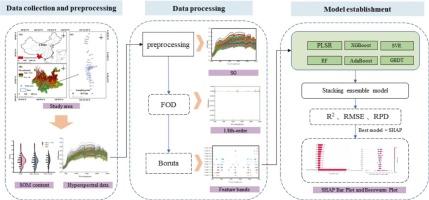Hyperspectral inversion of organic matter content in agricultural soils based on fractional-order derivative and ensemble learning
IF 3.4
3区 物理与天体物理
Q2 INSTRUMENTS & INSTRUMENTATION
引用次数: 0
Abstract
Hyperspectral technology shows great potential for rapidly monitoring soil organic matter (SOM) in farmland. To improve prediction accuracy and model stability, this study proposes a new SOM inversion strategy based on the Stacking ensemble learning framework. By applying fractional-order derivative (FOD) processing to hyperspectral data, the spectral data quality is effectively enhanced. Feature selection was performed using the Boruta algorithm, and the modeling performance of six common machine learning algorithms, including Partial Least Squares Regression (PLSR), Support Vector Regression (SVR), Extreme Gradient Boosting (XGBoost), Random Forest (RF), Adaptive Boosting (AdaBoost), and Gradient Boosting Decision Tree (GBDT), was evaluated and compared. The results show that FOD outperforms traditional integer-order differential methods in modeling. Under the 1.8-order FOD processing, the prediction performance of all models improved significantly. Among them, the Stacking ensemble model combining SVR, RF, AdaBoost, and GBDT achieved the best performance on the test set, with an R2 of 0.83, surpassing the R2 of the best single model, GBDT (0.81). Additionally, SHAP value analysis further confirmed the effectiveness of combining FOD, Boruta, and Stacking strategies, greatly improving SOM prediction accuracy. This study offers a novel and effective technical approach for the rapid and accurate inversion of SOM content in farmland soil.

基于分数阶导数和集合学习的农业土壤有机质含量高光谱反演
高光谱技术在农田土壤有机质快速监测中显示出巨大的潜力。为了提高预测精度和模型稳定性,本文提出了一种基于叠加集成学习框架的SOM反演策略。通过对高光谱数据进行分数阶导数(FOD)处理,有效地提高了光谱数据的质量。使用Boruta算法进行特征选择,并评估和比较了6种常用机器学习算法的建模性能,包括偏最小二乘回归(PLSR)、支持向量回归(SVR)、极端梯度增强(XGBoost)、随机森林(RF)、自适应增强(AdaBoost)和梯度增强决策树(GBDT)。结果表明,该方法在建模方面优于传统的整阶微分方法。在1.8阶FOD处理下,所有模型的预测性能都有显著提高。其中,结合SVR、RF、AdaBoost和GBDT的Stacking ensemble模型在测试集上的表现最佳,R2为0.83,超过了最佳单一模型GBDT的R2(0.81)。此外,SHAP值分析进一步证实了FOD、Boruta和Stacking策略相结合的有效性,大大提高了SOM的预测精度。本研究为快速准确地反演农田土壤中SOM含量提供了一种新颖有效的技术途径。
本文章由计算机程序翻译,如有差异,请以英文原文为准。
求助全文
约1分钟内获得全文
求助全文
来源期刊
CiteScore
5.70
自引率
12.10%
发文量
400
审稿时长
67 days
期刊介绍:
The Journal covers the entire field of infrared physics and technology: theory, experiment, application, devices and instrumentation. Infrared'' is defined as covering the near, mid and far infrared (terahertz) regions from 0.75um (750nm) to 1mm (300GHz.) Submissions in the 300GHz to 100GHz region may be accepted at the editors discretion if their content is relevant to shorter wavelengths. Submissions must be primarily concerned with and directly relevant to this spectral region.
Its core topics can be summarized as the generation, propagation and detection, of infrared radiation; the associated optics, materials and devices; and its use in all fields of science, industry, engineering and medicine.
Infrared techniques occur in many different fields, notably spectroscopy and interferometry; material characterization and processing; atmospheric physics, astronomy and space research. Scientific aspects include lasers, quantum optics, quantum electronics, image processing and semiconductor physics. Some important applications are medical diagnostics and treatment, industrial inspection and environmental monitoring.

 求助内容:
求助内容: 应助结果提醒方式:
应助结果提醒方式:


